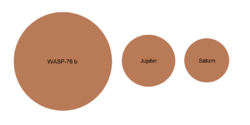Astronomy:WASP-76
From HandWiki
Short description: Star in the Pisces constellation
| Observation data Equinox J2000.0]] (ICRS) | |
|---|---|
| Constellation | Pisces |
| Right ascension | 01h 46m 31.8577s[1] |
| Declination | 02° 42′ 02.0332″[1] |
| Apparent magnitude (V) | 9.52[2] |
| Characteristics | |
| Evolutionary stage | main sequence star |
| Spectral type | F7V |
| B−V color index | 0.61 |
| J−H color index | 0.21 |
| J−K color index | 0.3 |
| Astrometry | |
| Radial velocity (Rv) | −1.152±0.0033[3] km/s |
| Proper motion (μ) | RA: 45.398[1] mas/yr Dec.: -40.819[1] mas/yr |
| Parallax (π) | 5.1204 ± 0.1579[1] mas |
| Distance | 640 ± 20 ly (195 ± 6 pc) |
| Details[4] | |
| Mass | 1.46±0.07 M☉ |
| Radius | 1.73±0.04 R☉ |
| Surface gravity (log g) | 4.4±0.1[5] cgs |
| Temperature | 6250±100 K |
| Metallicity [Fe/H] | 0.23±0.1 dex |
| Rotational velocity (v sin i) | 3.3±0.6[5] km/s |
| Age | 5.3+6.1−2.9[5] Gyr |
| Other designations | |
WASP-76, 2MASS J01463185+0242019, Gaia DR2 2512326349403275520 | |
| Database references | |
| SIMBAD | data |
WASP-76, also known as BD+01 316, is a yellow-white main sequence star in the constellation of Pisces. Since 2014, it has had one suspected stellar companion at a projected separation of 85 astronomical units.[6][7]
Planetary system

Size comparison of WASP-76 b, Jupiter and Saturn
The "hot Jupiter" class planet WASP-76b was discovered around WASP-76 in 2013.
| Companion (in order from star) |
Mass | Semimajor axis (AU) |
Orbital period (days) |
Eccentricity | Inclination | Radius |
|---|---|---|---|---|---|---|
| b | 0.92±0.03 MJ | 0.033 | 1.809886±0.000001 | 0 | 88.0±1.6° | 1.83±0.06 RJ |
References
- ↑ 1.0 1.1 1.2 1.3 1.4 Brown, A. G. A. (August 2018). "Gaia Data Release 2: Summary of the contents and survey properties". Astronomy & Astrophysics 616: A1. doi:10.1051/0004-6361/201833051. Bibcode: 2018A&A...616A...1G. Gaia DR2 record for this source at VizieR.
- ↑ Høg, E. (2000). "The Tycho-2 catalogue of the 2.5 million brightest stars". Astronomy and Astrophysics 355: L27–L30. Bibcode: 2000A&A...355L..27H.
- ↑ Soubiran, C.; Jasniewicz, G.; Chemin, L.; Zurbach, C.; Brouillet, N.; Panuzzo, P.; Sartoretti, P.; Katz, D. et al. (2018). "Gaia Data Release 2. The catalogue of radial velocity standard stars". Astronomy and Astrophysics 616: A7. doi:10.1051/0004-6361/201832795. Bibcode: 2018A&A...616A...7S.
- ↑ Martin, Pierre-Yves (2023). "Planet WASP-76 b" (in en). https://exoplanet.eu/catalog/wasp_76_b--1420/.
- ↑ 5.0 5.1 5.2 West, R. G.; Hellier, C.; Almenara, J.-M.; Anderson, D. R.; Barros, S. C. C.; Bouchy, F.; Brown, D. J. A.; Collier Cameron, A. et al. (2016). "Three irradiated and bloated hot Jupiters". Astronomy & Astrophysics 585: A126. doi:10.1051/0004-6361/201527276.
- ↑ Ngo, Henry; Knutson, Heather A.; Hinkley, Sasha; Bryan, Marta; Crepp, Justin R.; Batygin, Konstantin; Crossfield, Ian; Hansen, Brad et al. (2016). "FRIENDS OF HOT JUPITERS. IV. STELLAR COMPANIONS BEYOND 50 au MIGHT FACILITATE GIANT PLANET FORMATION, BUT MOST ARE UNLIKELY TO CAUSE KOZAI–LIDOV MIGRATION". The Astrophysical Journal 827 (1): 8. doi:10.3847/0004-637X/827/1/8. Bibcode: 2016ApJ...827....8N.
- ↑ Ginski, C.; Mugrauer, M.; Seeliger, M.; Buder, S.; Errmann, R.; Avenhaus, H.; Mouillet, D.; Maire, A.-L. et al. (2016). "A lucky imaging multiplicity study of exoplanet host stars – II". Monthly Notices of the Royal Astronomical Society 457 (2): 2173–2191. doi:10.1093/mnras/stw049. Bibcode: 2016MNRAS.457.2173G.
- ↑ Planet WASP-76 b at exoplanet.eu
External links
 |

